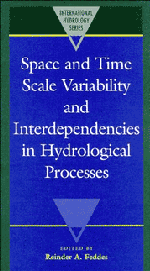Book contents
- Frontmatter
- Contents
- Acknowledgement
- OPENING ADDRESS OF THE FIRST GEORGE KOVACS COLLOQUIUM
- HETEROGENEITY AND SCALING LAND-ATMOSPHERIC WATER AND ENERGY FLUXES IN CLIMATE SYSTEMS
- SCALE PROBLEMS IN SURFACE FLUXES
- REMOTE SENSING – INVERSE MODELLING APPROACH TO DETERMINE LARGE SCALE EFFECTIVE SOIL HYDRAULIC PROPERTIES IN SOIL–VEGETATION–ATMOSPHERE SYSTEMS
- THE IMPORTANCE OF LANDSCAPE POSITION IN SCALING SVAT MODELS TO CATCHMENT SCALE HYDROECOLOGICAL PREDICTION
- THE INFLUENCE OF SUBGRID-SCALE SPATIAL VARIABILITY ON PRECIPITATION AND SOIL MOISTURE IN AN ATMOSPHERIC GCM
- MODELLING THE HYDROLOGICAL RESPONSE TO LARGE SCALE LAND USE CHANGE
- AN APPROACH TO REPRESENT MESOSCALE (SUBGRID-SCALE) FLUXES IN GCMs DEMONSTRATED WITH SIMULATIONS OF LOCAL DEFORESTATION IN AMAZONIA
- A HIERARCHICAL APPROACH TO THE CONNECTION OF GLOBAL HYDROLOGICAL AND ATMOSPHERIC MODELS
- STOCHASTIC DOWNSCALING OF GCM-OUTPUT RESULTS USING ATMOSPHERIC CIRCULATION PATTERNS
- DEPENDENCIES OF SPATIAL VARIABILITY IN FLUVIAL ECOSYSTEMS ON THE TEMPORAL HYDROLOGICAL VARIABILITY
- PROBLEMS AND PROGRESS IN MACROSCALE HYDROLOGICAL MODELLING
- PREDICTABILITY OF THE ATMOSPHERE AND CLIMATE: TOWARDS A DYNAMICAL VIEW
- FROM SCALAR CASCADES TO LIE CASCADES: JOINT MULTIFRACTAL ANALYSIS OF RAIN AND CLOUD PROCESSES
- FRACTALS ET MULTIFRACTALS APPLIQUÉS À L'ÉTUDE DE LA VARIABILITÉ TEMPORELLE DES PRÉCIPITATIONS
FROM SCALAR CASCADES TO LIE CASCADES: JOINT MULTIFRACTAL ANALYSIS OF RAIN AND CLOUD PROCESSES
Published online by Cambridge University Press: 05 November 2011
- Frontmatter
- Contents
- Acknowledgement
- OPENING ADDRESS OF THE FIRST GEORGE KOVACS COLLOQUIUM
- HETEROGENEITY AND SCALING LAND-ATMOSPHERIC WATER AND ENERGY FLUXES IN CLIMATE SYSTEMS
- SCALE PROBLEMS IN SURFACE FLUXES
- REMOTE SENSING – INVERSE MODELLING APPROACH TO DETERMINE LARGE SCALE EFFECTIVE SOIL HYDRAULIC PROPERTIES IN SOIL–VEGETATION–ATMOSPHERE SYSTEMS
- THE IMPORTANCE OF LANDSCAPE POSITION IN SCALING SVAT MODELS TO CATCHMENT SCALE HYDROECOLOGICAL PREDICTION
- THE INFLUENCE OF SUBGRID-SCALE SPATIAL VARIABILITY ON PRECIPITATION AND SOIL MOISTURE IN AN ATMOSPHERIC GCM
- MODELLING THE HYDROLOGICAL RESPONSE TO LARGE SCALE LAND USE CHANGE
- AN APPROACH TO REPRESENT MESOSCALE (SUBGRID-SCALE) FLUXES IN GCMs DEMONSTRATED WITH SIMULATIONS OF LOCAL DEFORESTATION IN AMAZONIA
- A HIERARCHICAL APPROACH TO THE CONNECTION OF GLOBAL HYDROLOGICAL AND ATMOSPHERIC MODELS
- STOCHASTIC DOWNSCALING OF GCM-OUTPUT RESULTS USING ATMOSPHERIC CIRCULATION PATTERNS
- DEPENDENCIES OF SPATIAL VARIABILITY IN FLUVIAL ECOSYSTEMS ON THE TEMPORAL HYDROLOGICAL VARIABILITY
- PROBLEMS AND PROGRESS IN MACROSCALE HYDROLOGICAL MODELLING
- PREDICTABILITY OF THE ATMOSPHERE AND CLIMATE: TOWARDS A DYNAMICAL VIEW
- FROM SCALAR CASCADES TO LIE CASCADES: JOINT MULTIFRACTAL ANALYSIS OF RAIN AND CLOUD PROCESSES
- FRACTALS ET MULTIFRACTALS APPLIQUÉS À L'ÉTUDE DE LA VARIABILITÉ TEMPORELLE DES PRÉCIPITATIONS
Summary
ABSTRACT There are two primary approaches to modeling rainfall; stochastic modeling and deterministic integration of nonlinear partial differential equations which model the atmospheric dynamics. The statistical advantages of the former could be combined with the physical advantages of the latter by exploiting cascade models based on scale invariant symmetries respected by the equations. Carried to its logical conclusion, this approach involves considering the atmosphere as a space-time multifractal process admitting either a vector, tensor or even only a nonlinear representation. The process is then defined by two groups which respectively specify the rule required to change from one scale to another and the corresponding transforms of fields. Both groups are characterized by their generators, hence by their Lie algebra. We show how to extend existing cascades beyond scalar processes, showing preliminary numerical simulations and data analyses, as well as indicating how to characterize and classify the scale invariant interactions of fields.
INTRODUCTION
The limitations of standard deterministic dynamical and of phenomenological stochastic modeling of rain
Geophysical fields show abundant evidence of nonlinear variability resulting from strong nonlinear interactions between different scales, different structures, and different fields. This variability is quite extreme and is associated with catastrophic events such as earthquakes, tornadoes, flash floods, extreme temperatures, volcanic eruptions. Another fundamental characteristic of this variability is the very large range of scales involved, which often extends from 10,000 km to 1 mm in space, and from geological scales to millisecond in time.
- Type
- Chapter
- Information
- Publisher: Cambridge University PressPrint publication year: 1995
- 16
- Cited by



